
 |
Tea Clipper |
 |
| from TeaAntiques.com | ||
| Edition Eighty Eight |
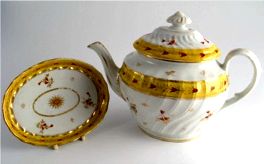 Yellow is the rarest colour to find used
on early English porcelain due to the complex nature of the firing; it was
unstable and so almost impossible to produce. As such, yellow ground porcelains
were very expensive and sought after at the time and a rare item for collectors
to find today. Although this teapot does have a hairline crack round its base, it is
sufficiently rare to warrant being acceptable to the collector.
Yellow is the rarest colour to find used
on early English porcelain due to the complex nature of the firing; it was
unstable and so almost impossible to produce. As such, yellow ground porcelains
were very expensive and sought after at the time and a rare item for collectors
to find today. Although this teapot does have a hairline crack round its base, it is
sufficiently rare to warrant being acceptable to the collector.
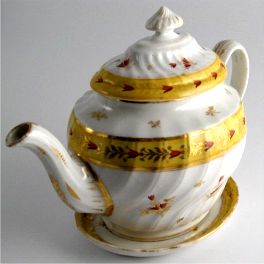
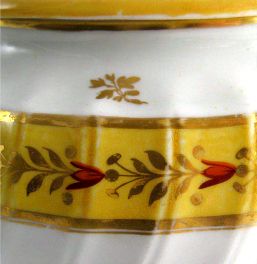
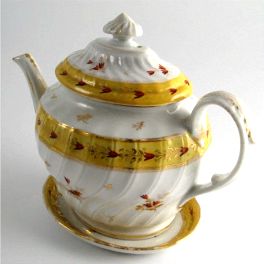
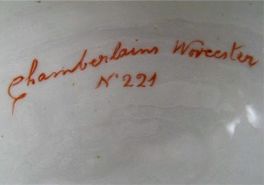
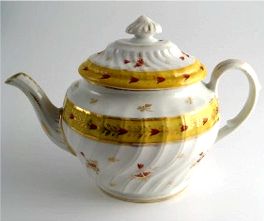 The
teapot is a delightful oval shape with moulded spiral shanked decoration. The teapot cover
has the 'Chamberlain Warranted' mark and pattern number 'No221' in red and on
the base of the teapot is the pattern number '221' in red. This pattern number
is listed in 'Chamberlain-Worcester Porcelain' by Geoffrey A. Godden as 'Shanked
yellow, red and gold bluebell border' taken from the original list of
Chamberlain patterns.
The
teapot is a delightful oval shape with moulded spiral shanked decoration. The teapot cover
has the 'Chamberlain Warranted' mark and pattern number 'No221' in red and on
the base of the teapot is the pattern number '221' in red. This pattern number
is listed in 'Chamberlain-Worcester Porcelain' by Geoffrey A. Godden as 'Shanked
yellow, red and gold bluebell border' taken from the original list of
Chamberlain patterns.
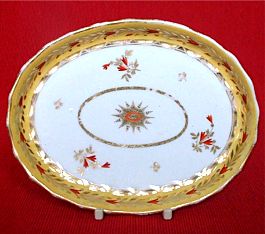 The matching teapot stand is an excellent example of this rare
colour ground. The border of the stand has this rich canary yellow which has
applied decoration of red flowers between elegant garlands of gilt foliage. This
giving a very elegant and rich decoration. This combined with the teapot are an
excellent example of this rare Chamberlain's Worcester colour.
The matching teapot stand is an excellent example of this rare
colour ground. The border of the stand has this rich canary yellow which has
applied decoration of red flowers between elegant garlands of gilt foliage. This
giving a very elegant and rich decoration. This combined with the teapot are an
excellent example of this rare Chamberlain's Worcester colour.
More details of this item and other tea related antiques can be found by visiting my web site at www.TeaAntiques.com.
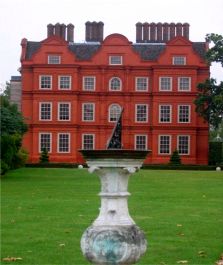 Many thousands of people flock each year to the Royal Botanical gardens at Kew,
a large garden covering over 300 acres and containing more than 40,000 plants
and 40 listed buildings, there is certainly a great deal to see and enjoy. In
the middle of the eighteenth century, things were somewhat different, when Kew
became the favoured retreat of King George III and his family. Much in the same
way as our present Queen retreats to Windsor Castle at the weekends, George III,
his wife Queen Charlotte and family retired to Kew to escape the bustling London
court.
Many thousands of people flock each year to the Royal Botanical gardens at Kew,
a large garden covering over 300 acres and containing more than 40,000 plants
and 40 listed buildings, there is certainly a great deal to see and enjoy. In
the middle of the eighteenth century, things were somewhat different, when Kew
became the favoured retreat of King George III and his family. Much in the same
way as our present Queen retreats to Windsor Castle at the weekends, George III,
his wife Queen Charlotte and family retired to Kew to escape the bustling London
court.
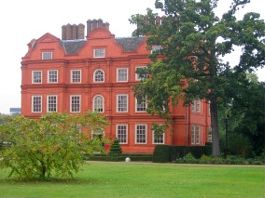 Kew in the eighteenth century was but a small village on the outskirts of
London. It was to become a favoured spot for the richer classes to build
themselves homes. In 1631 one such person, a London merchant called Samuel
Fortrey, built himself a beautiful brick mansion house on the south bank of the
River Thames at Kew. In the early eighteenth century, this house was let out to
tenants and; these were soon to be the Royal family.
Kew in the eighteenth century was but a small village on the outskirts of
London. It was to become a favoured spot for the richer classes to build
themselves homes. In 1631 one such person, a London merchant called Samuel
Fortrey, built himself a beautiful brick mansion house on the south bank of the
River Thames at Kew. In the early eighteenth century, this house was let out to
tenants and; these were soon to be the Royal family.
The first Royal tenants to be attracted to Kew were King George II (1727-60) and his wife Queen Caroline of Ansbach. They themselves resided in nearby Richmond Lodge, but thought Kew a perfect house in which to lodge their three eldest daughters, Anne, Caroline and Amelia. They thus rented the house from 1729. George II and Queen Charlotte's son and heir, Frederick, Prince of Wales rebuilt the White House that stood opposite to Kew Palace and resided there. Unlike his father, Frederick was cultivated and moved freely in society, loving art and architecture. He was responsible for laying the foundation of the botanic garden at Kew and employed William Kent and William Chambers to design and build some of the buildings there. He introduced the chinoiserie buildings dotted about the gardens.
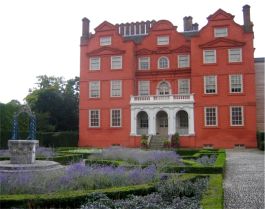 Things took a turn in 1751, when Frederick died unexpectedly after being struck
on the head with a cricket ball during a game of cricket. His widow, Augusta,
Princess of Wales continued to work on the development of Kew gardens. With
William Chambers the architect and gardener William Aiton, they created the
extraordinary garden and buildings within it, including a mosque, a Moorish
Alhambra and not least the beautiful red brick Pagoda. Augusta's son George,
upon the death of his father Frederick, became the Prince of Wales. he was a shy
young man who enjoyed horticulture, agriculture and the arts. The palace at Kew
then became known as the Prince of Wales's house.
Things took a turn in 1751, when Frederick died unexpectedly after being struck
on the head with a cricket ball during a game of cricket. His widow, Augusta,
Princess of Wales continued to work on the development of Kew gardens. With
William Chambers the architect and gardener William Aiton, they created the
extraordinary garden and buildings within it, including a mosque, a Moorish
Alhambra and not least the beautiful red brick Pagoda. Augusta's son George,
upon the death of his father Frederick, became the Prince of Wales. he was a shy
young man who enjoyed horticulture, agriculture and the arts. The palace at Kew
then became known as the Prince of Wales's house.
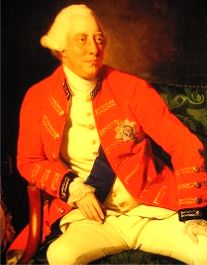 In 1760, George became King George III. It was on a journey from London to Kew,
that he was stopped near Chiswick and informed that King George II had died at
Kensington Palace and that he was now the new King. In 1761 he married his young
bride, Charlotte Sophia, Princes of Mecklenburg-Strelitz. This was an arranged
marriage and she had been the least known of the Princesses on the list of
suitable candidates to marry the King. Fortunately, it was a good choice and for
many years a long and happy marriage, until the Kings 'madness' set in! During
their marriage they had 15 children, but astonishingly, only one grandchild.
In 1760, George became King George III. It was on a journey from London to Kew,
that he was stopped near Chiswick and informed that King George II had died at
Kensington Palace and that he was now the new King. In 1761 he married his young
bride, Charlotte Sophia, Princes of Mecklenburg-Strelitz. This was an arranged
marriage and she had been the least known of the Princesses on the list of
suitable candidates to marry the King. Fortunately, it was a good choice and for
many years a long and happy marriage, until the Kings 'madness' set in! During
their marriage they had 15 children, but astonishingly, only one grandchild.
From 1764, King George and Queen Charlotte took over Richmond Lodge and with their ever increasing family rented various houses around Kew Green to house them. The children were watched over by a governess, Lady Charlotte Finch.
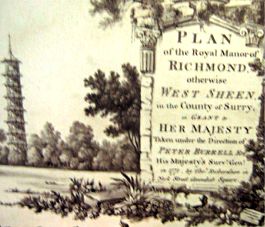 With the family enjoying their time in the Kew area, there were plans to build a
great classical palace at Richmond to the designs of Chambers. However, these
plans were abandoned. He did build an Observatory for the King, who was
interested in astronomical study and a 'cottage' for Queen Charlotte, which they
used for a picnic retreat. It also functioned as a tea house or pavilion.
With the family enjoying their time in the Kew area, there were plans to build a
great classical palace at Richmond to the designs of Chambers. However, these
plans were abandoned. He did build an Observatory for the King, who was
interested in astronomical study and a 'cottage' for Queen Charlotte, which they
used for a picnic retreat. It also functioned as a tea house or pavilion.
In 1772, the King's mother, the Dowager Princess Augusta died at Carlton House in London. Shortly afterwards, King George III with his family moved from Richmond Lodge to his old childhood home, the White House at Kew, as the summer retreat. George III inherited the 300 acres of the two neighbouring estates of Richmond and Kew - now forming the Royal Botanical gardens. For George, who was often referred to as 'Farmer George', it must have seemed like heaven. The gardens and their development, I will cover in a future newsletter, but for now my interest is in Kew Palace itself.
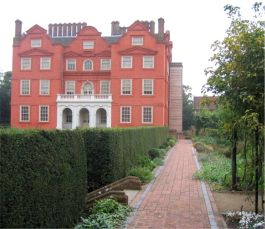
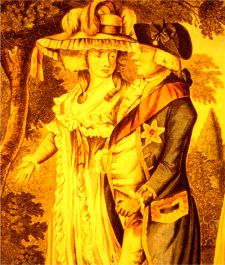 King George and Queen Charlotte's eldest son George, Prince of Wales aged 8 and
his brother Frederick moved into Kew palace with their governor Lord Holderness
and their own household. Here they would gain their education, in much the same
way as their father George III had done. As part of their education, they
learned about farming and were reputed to have grown a patch of wheat in the
garden behind Kew palace and used it to make a loaf of bread for the Royal
table. When the King and Queen were staying at the White House, their children
would be brought from the various houses they lived in around Kew to breakfast
with the King and Queen. If they had no lessons to attend, they might then have
enjoyed a walk in the gardens with them. There were public open days for the
gardens, on Sundays Richmond gardens and Thursdays Kew gardens would open to the
public who would arrive in their carriages in their number with the chance to
spy the King and his family.
King George and Queen Charlotte's eldest son George, Prince of Wales aged 8 and
his brother Frederick moved into Kew palace with their governor Lord Holderness
and their own household. Here they would gain their education, in much the same
way as their father George III had done. As part of their education, they
learned about farming and were reputed to have grown a patch of wheat in the
garden behind Kew palace and used it to make a loaf of bread for the Royal
table. When the King and Queen were staying at the White House, their children
would be brought from the various houses they lived in around Kew to breakfast
with the King and Queen. If they had no lessons to attend, they might then have
enjoyed a walk in the gardens with them. There were public open days for the
gardens, on Sundays Richmond gardens and Thursdays Kew gardens would open to the
public who would arrive in their carriages in their number with the chance to
spy the King and his family.
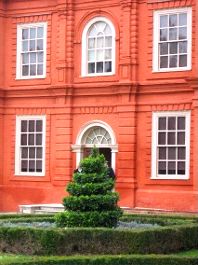
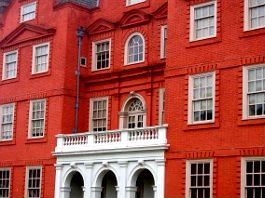
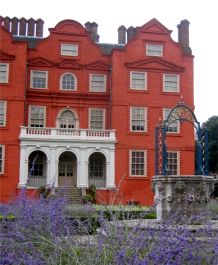
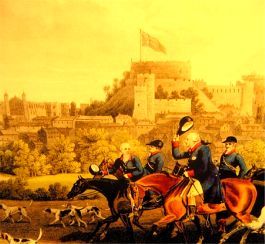 The idyllic life was to come to an end during the later years of their lives
when the King was struck with an illness, Porphyry, thought to be madness. The
first evidence of the illness was from a letter that the King wrote from Kew on
17th June 1788, to his son, complaining of a bilious attack. By that November,
his symptoms included mental degeneration and it was felt that the King should
retire to Kew from Windsor Castle, where he would not be in the public eye. The
Queen and her Princess' travelled to Kew ahead of the King in a hope that the
King would follow, which he did. He remained at the White House from
November 1788 until his recovery in March 1789. This was the longest stay he had
at the White House during his long reign. Kew Palace was brought into use to
house the King's Groom of the Bed Chamber, who received all enquiries regarding
the King's health. It also provided necessary overflow accommodation as and
when needed.
The idyllic life was to come to an end during the later years of their lives
when the King was struck with an illness, Porphyry, thought to be madness. The
first evidence of the illness was from a letter that the King wrote from Kew on
17th June 1788, to his son, complaining of a bilious attack. By that November,
his symptoms included mental degeneration and it was felt that the King should
retire to Kew from Windsor Castle, where he would not be in the public eye. The
Queen and her Princess' travelled to Kew ahead of the King in a hope that the
King would follow, which he did. He remained at the White House from
November 1788 until his recovery in March 1789. This was the longest stay he had
at the White House during his long reign. Kew Palace was brought into use to
house the King's Groom of the Bed Chamber, who received all enquiries regarding
the King's health. It also provided necessary overflow accommodation as and
when needed.
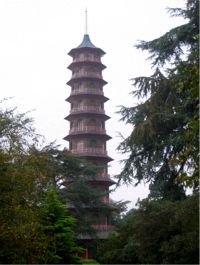 The King was kept locked away and separated from his wife and family who he had
thought he was to join at Kew. In the start of the new Year, his health had
improved and the Queen and Princesses started to pay short visits to him in his
apartments. The King was allowed to go for walks in the gardens, but on one
occasion when he found the pagoda locked, he laid on the grass and refused to
get up and finally had to be carried back to the Palace.
The King was kept locked away and separated from his wife and family who he had
thought he was to join at Kew. In the start of the new Year, his health had
improved and the Queen and Princesses started to pay short visits to him in his
apartments. The King was allowed to go for walks in the gardens, but on one
occasion when he found the pagoda locked, he laid on the grass and refused to
get up and finally had to be carried back to the Palace.
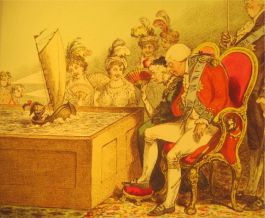 As the King's health improved, he was heard to proclaim his singular expression
'what! what! what!' - a sure sign of his recovery. Upon his recovery, on March
10th he had recovered and rode to Westminster to deliver a speech to Parliament.
His son's plans, as Prince of Wales, to form a Regency to take control from a
'mad King' had been avoided and the King continued to reign. However, his
illness was to return later resulting in belts of madness.
As the King's health improved, he was heard to proclaim his singular expression
'what! what! what!' - a sure sign of his recovery. Upon his recovery, on March
10th he had recovered and rode to Westminster to deliver a speech to Parliament.
His son's plans, as Prince of Wales, to form a Regency to take control from a
'mad King' had been avoided and the King continued to reign. However, his
illness was to return later resulting in belts of madness.
In 1801, he had a return of the illness. Kew Palace in the mean time, had in 1799, been refurbished and furnished with some furniture from the White House, which had fallen into disrepair, in preparation for a visit. The lease on the properties at Kew had finally been bought by the King. In 1802 the White House was demolished. In April 1801, the Queen and the Princesses moved to Kew. She was afraid of King when he was in his state of madness and expected to stay at Kew Palace while he recovered. However, the King Rode to Kew Palace and joined her there, much to her distress. His doctors in the end, were forced into tricking the King into the Dining Room at Kew palace by asking him about a painting above the fireplace there - A self portrait of Nogari in the style of Van Dyke, that remains there today. They then had him locked in the apartments in the White house that he had been locked in during his earlier bought of madness. All communication between the King and the family in Kew Palace were forbidden.
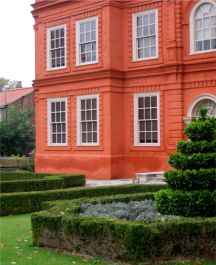
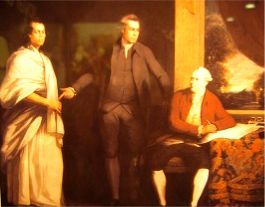
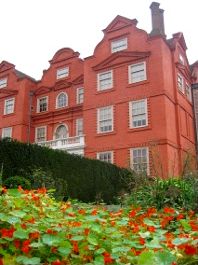
The King, as his health improved, was allowed to walk in the gardens. During his illness he was also well enough to sign state papers. By 19th May, the King was at a state where he could not stand the situation any longer and insisted that he be re-united with his family in Kew Palace, otherwise he said that he would not sign another state document ever again. He was then allowed to join his family, from which point his heath continued to improve once more.
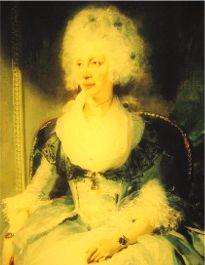
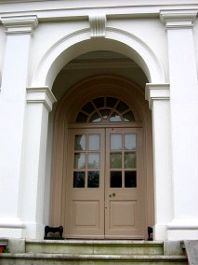 A third return of his illness came early in 1804, he showed no sign of recovery
and by June was once again moved to Kew. This time secure rooms were made ready
for him in the service wing of Kew Palace. So, at least this time he resided in
the same house as his family, even if he did not see the Queen. He did get to
dine with some of his daughters. His recovery was never complete, although they
did take trips to Weymouth for sea bathing. As the King approached his golden
jubilee in 1810, he withdrew more and more to Windsor, as did the Queen. From
June 1811 the King was never seen outside of Windsor and his son, George, Prince
of Wales, had become Prince Regent. The Queen continued to visit Kew Palace for
the 'benefit of the air'. Her health by 1818 had deteriorated and on June 22nd
retired to Kew for supposedly a few days. The Queen finally died in Kew
palace on 17th November. It was thought the news would be too distressing for
the King, so it was kept from him. Even her funeral cortège to Windsor castle
was kept quiet by the laying of straw in the courtyard to prevent the King from
hearing the noise of the horse's feet on the cobbles. As it happens the King was
in no state of mind to notice. George III died at Windsor castle on 19th
January 1820. Kew, during his life had changed from being a place of happiness
and fond memories with his devoted wife and family, to one of hate with it as
his prison.
A third return of his illness came early in 1804, he showed no sign of recovery
and by June was once again moved to Kew. This time secure rooms were made ready
for him in the service wing of Kew Palace. So, at least this time he resided in
the same house as his family, even if he did not see the Queen. He did get to
dine with some of his daughters. His recovery was never complete, although they
did take trips to Weymouth for sea bathing. As the King approached his golden
jubilee in 1810, he withdrew more and more to Windsor, as did the Queen. From
June 1811 the King was never seen outside of Windsor and his son, George, Prince
of Wales, had become Prince Regent. The Queen continued to visit Kew Palace for
the 'benefit of the air'. Her health by 1818 had deteriorated and on June 22nd
retired to Kew for supposedly a few days. The Queen finally died in Kew
palace on 17th November. It was thought the news would be too distressing for
the King, so it was kept from him. Even her funeral cortège to Windsor castle
was kept quiet by the laying of straw in the courtyard to prevent the King from
hearing the noise of the horse's feet on the cobbles. As it happens the King was
in no state of mind to notice. George III died at Windsor castle on 19th
January 1820. Kew, during his life had changed from being a place of happiness
and fond memories with his devoted wife and family, to one of hate with it as
his prison.
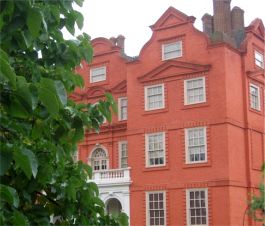
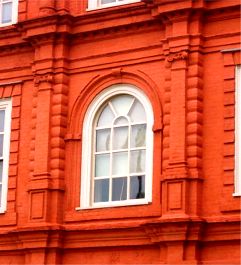 After over 150 years of neglect and abandonment, Kew Palace has once again been
brought to life. So, what do we see at Kew palace to day after its recent
restoration? It, for me brought me about as close I could feel to King George
III and Queen Charlotte as a devoted family away from their public lives. With
the use of active displays and clever interpretations, the Palace offers us a
chance to see it as it was during the Reign of George III.
After over 150 years of neglect and abandonment, Kew Palace has once again been
brought to life. So, what do we see at Kew palace to day after its recent
restoration? It, for me brought me about as close I could feel to King George
III and Queen Charlotte as a devoted family away from their public lives. With
the use of active displays and clever interpretations, the Palace offers us a
chance to see it as it was during the Reign of George III.
Kew palace is certainly a most handsome of buildings. It is in the Dutch style, built of red brick and with shaped gables. The walls of the palace have a red lime wash, that makes it appear to stand out even more so than had it been just brick.
Entering the Palace through the front door leads to a narrow Hall and Ante-Room. It may seem to be rather a small Hall. Originally, when the house was built, what is now the stone floored dining room to the right, would have formed part of the entrance hall. Separate dining rooms did not become fashionable unto later in the eighteenth century.
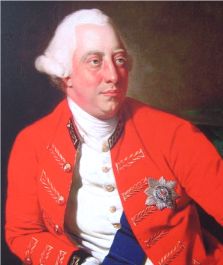 To the left as you enter the Hall is a small room, this was the Ante Room. It
has dark linenfold wood panelling on its walls, this was taken from one of the
other older houses nearby and re-used here. On a pedestal in the corner, a most
life like bust of King George III. This bust was taken from a cast of a waxworks
likeness made for the King's Golden Jubilee in 1810 by Madame Tussaud, the
famous creator of waxworks models. It was quite eerie to look King George III in the
eye. It was almost as if he was there and ready to greet you into his Palace. A
verbal recording of King George III gives an insight into this, the most famous
inhabitant of the palace.
To the left as you enter the Hall is a small room, this was the Ante Room. It
has dark linenfold wood panelling on its walls, this was taken from one of the
other older houses nearby and re-used here. On a pedestal in the corner, a most
life like bust of King George III. This bust was taken from a cast of a waxworks
likeness made for the King's Golden Jubilee in 1810 by Madame Tussaud, the
famous creator of waxworks models. It was quite eerie to look King George III in the
eye. It was almost as if he was there and ready to greet you into his Palace. A
verbal recording of King George III gives an insight into this, the most famous
inhabitant of the palace.
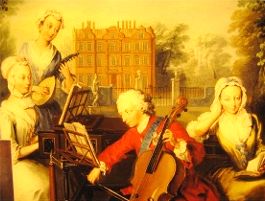 Moving on through you enter what was the King's Library. George was an avid book
collector and had Libraries in each of his Palaces. His collection of some
65,000 books later went to form the nucleus of the British Library. Today, this
room is devoid of books, except for a few within a display cabinet in the centre
of the room. Here too are some other items that belonged to the King or
documents that he had written in his own hand. This display does change from
time to time. When I was there it included a Meissen porcelain flute and flute
holder that belonged to the King. It is in white glazed porcelain decorated with
a garland of flowers which is wrapped round it spiralling along its entire
length. He was a keen musician and loved to play the flute and
Harpsichord. He adored Handel and his music and Handel would often play for his
entertainment. One of the Kings musicians recalled playing for the King and his
family on the lawn outside the Palace while the family dined in the dining room.
He collected some small programmes of music selected by the King, which included
pieces by Handel, written in the King's hand and now on display here. Another
item in the cabinet was a gold pocket watch of the King.
Moving on through you enter what was the King's Library. George was an avid book
collector and had Libraries in each of his Palaces. His collection of some
65,000 books later went to form the nucleus of the British Library. Today, this
room is devoid of books, except for a few within a display cabinet in the centre
of the room. Here too are some other items that belonged to the King or
documents that he had written in his own hand. This display does change from
time to time. When I was there it included a Meissen porcelain flute and flute
holder that belonged to the King. It is in white glazed porcelain decorated with
a garland of flowers which is wrapped round it spiralling along its entire
length. He was a keen musician and loved to play the flute and
Harpsichord. He adored Handel and his music and Handel would often play for his
entertainment. One of the Kings musicians recalled playing for the King and his
family on the lawn outside the Palace while the family dined in the dining room.
He collected some small programmes of music selected by the King, which included
pieces by Handel, written in the King's hand and now on display here. Another
item in the cabinet was a gold pocket watch of the King.
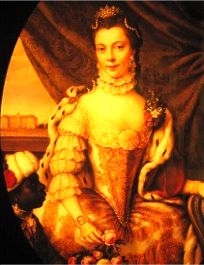 Against the wall of this room stands a very handsome long case clock by Thomas
Tompian, one of the finest clock makers of the period. On one of the walls a
fine portrait of Princess Charlotte of Mecklenburg-Strelitz, the future wife of
George III. It shows her beautifully attired in a white and gold dress, ermine
edged robe and pearl tiara. To her right is her young black page boy, in his
livery dress and holding for her a basket of roses. This was painted by the
Danish Artist Johann Georg Ziesenis, c1761.
Against the wall of this room stands a very handsome long case clock by Thomas
Tompian, one of the finest clock makers of the period. On one of the walls a
fine portrait of Princess Charlotte of Mecklenburg-Strelitz, the future wife of
George III. It shows her beautifully attired in a white and gold dress, ermine
edged robe and pearl tiara. To her right is her young black page boy, in his
livery dress and holding for her a basket of roses. This was painted by the
Danish Artist Johann Georg Ziesenis, c1761.
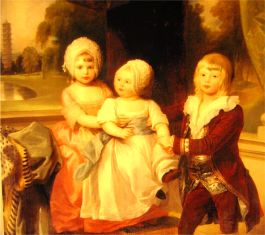 Passing into the next room at the back of the house, is the Pages' Waiting Room.
This room was used by servants waiting to attend the Queen. There is a door to
the left as you enter this room, it is through this door that led to the
servant wing (now demolished), at one time converted and used to house the King
in confinement during one of his bought of madness in 1804-5. In the Pages'
Waiting Room today, there is a film slide show introducing the Queen and her 15
children.
Passing into the next room at the back of the house, is the Pages' Waiting Room.
This room was used by servants waiting to attend the Queen. There is a door to
the left as you enter this room, it is through this door that led to the
servant wing (now demolished), at one time converted and used to house the King
in confinement during one of his bought of madness in 1804-5. In the Pages'
Waiting Room today, there is a film slide show introducing the Queen and her 15
children.
Moving out of the Pages' Waiting Room, you make your way back toward the front of the house along the narrow Hall and turn left into the Dining Room. This room was remodelled by William Kent in the mid 1730's. Kent did retain the original strapwork plaster that forms the frieze at the top of the walls. Kent installed the large Portland stone chimney-piece above which hangs the self portrait of Nogari in the style of Van Dyke painting which the doctors used to entice the King from the Library into this room where his doctor was waiting for him. Having once been a hall would perhaps account for the stone floor.
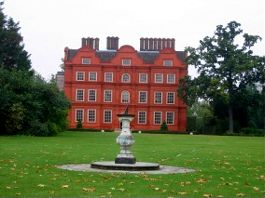 There is a large rectangular dining table in the centre of the room, about which
a set of Regency style dining chairs. On the table are a set of modern plates
commissioned with quotes written on them from friends and famous people of the
day, that met the King. Such people as Samuel Johnson, writer of the great
English dictionary.
There is a large rectangular dining table in the centre of the room, about which
a set of Regency style dining chairs. On the table are a set of modern plates
commissioned with quotes written on them from friends and famous people of the
day, that met the King. Such people as Samuel Johnson, writer of the great
English dictionary.
A large wooden cased organ from the c1730's stands to one end of the room. King George III loved to here Handel's organ works, Handel himself a great organist. It is known from original accounts that an organ was housed in the dining room, but this is not the original.
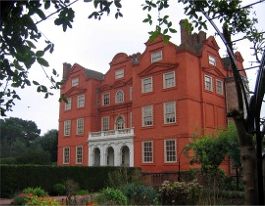 Moving out of the Dining Room, to the room behind at the back of the house, is
the King's Breakfast Room. In the late eighteenth century, it was recorded that
this room contained a small dining table with a set of six 'Grecian shape'
chairs and would have been used for informal dining. Today, it contains display
cases with many interesting items belonging to or associated with the King and
Queen and their family. For me one of the thrilling things to see was a
porcelain tea canister and a tea cup and saucer from one of the tea services
made for the King and Kew Palace in the eighteenth century. These are from the
Worcester factory and date from c1780, made from soft paste porcelain, they are
decorated with a cobalt blue border, bouquets of flowers in coloured enamels and
also in the centre of the decoration, a classical vase on which is the name
'KEW'. How wonderful that these pieces are now back in their original home and
for us to enjoy.
Moving out of the Dining Room, to the room behind at the back of the house, is
the King's Breakfast Room. In the late eighteenth century, it was recorded that
this room contained a small dining table with a set of six 'Grecian shape'
chairs and would have been used for informal dining. Today, it contains display
cases with many interesting items belonging to or associated with the King and
Queen and their family. For me one of the thrilling things to see was a
porcelain tea canister and a tea cup and saucer from one of the tea services
made for the King and Kew Palace in the eighteenth century. These are from the
Worcester factory and date from c1780, made from soft paste porcelain, they are
decorated with a cobalt blue border, bouquets of flowers in coloured enamels and
also in the centre of the decoration, a classical vase on which is the name
'KEW'. How wonderful that these pieces are now back in their original home and
for us to enjoy.
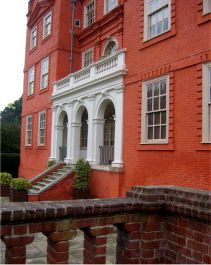 Moving back into the Hall and up the quite plain staircase to the first floor of
the Palace, turning right at the top takes you into the Queen's Boudoir. This is
a very striking room, with its walls painted a light blue trimmed at the edge
with an Etruscan or Greek key paper strip. This decoration was based on a
fragment of the paper strip found elsewhere in the Palace. The windows are
dressed with a lavishly designed chintz fabric in gold and black. Furniture in
the room is very much of the Regency period and include a set of seat furniture,
these with black japanned and partially gilded frames, covered in the same
chintz material as the curtains. There set includes open armchairs, with sabre
shaped legs and a day bed. In the centre of the room, a Regency folding card
table, this laid ready for cards with mother of pearl gaming chips. The
strapwork ceiling survives from the earlier house decoration.
Moving back into the Hall and up the quite plain staircase to the first floor of
the Palace, turning right at the top takes you into the Queen's Boudoir. This is
a very striking room, with its walls painted a light blue trimmed at the edge
with an Etruscan or Greek key paper strip. This decoration was based on a
fragment of the paper strip found elsewhere in the Palace. The windows are
dressed with a lavishly designed chintz fabric in gold and black. Furniture in
the room is very much of the Regency period and include a set of seat furniture,
these with black japanned and partially gilded frames, covered in the same
chintz material as the curtains. There set includes open armchairs, with sabre
shaped legs and a day bed. In the centre of the room, a Regency folding card
table, this laid ready for cards with mother of pearl gaming chips. The
strapwork ceiling survives from the earlier house decoration.
In the next room, which is at the front of the Palace is the Queen's Drawing Room. This room has pale pink panelled walls. The colour was found when the many paint layers were taken back in the restoration process. This is one of the grandest rooms in the Place and would have been used for more formal entertaining. It also saw the hasty double marriage of two of the Queen's middle aged Princes in a race to produce an heir to the throne, in 1818. The marriages were held in this room, as Queen Charlotte was then too ill to move from Kew back to London.
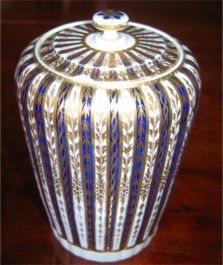 In the Queen's drawing room today, is a very fine Regency mahogany sofa table
positioned in front of a settee. On the table a silver teapot with its stand and
a tea kettle made by Robert Garrad in 1803, these have Queen Charlottes
monogram, a 'C' on one side and Princes Augusta Sophia's, 'AS' on the other -
presumably from when her eldest un-married daughter inherited them. Also on the
table are a porcelain tea canister and two cups and saucers, these from the
Worcester factory, 'Flight' period, c1790 (Like the one illustrated here from my
personal collection). The King and Queen visited the
Worcester factory in 1788 and commissioned several services from them, as did
other members of the Royal family, for their Palaces. They were great supporters
of the British porcelain industry.
In the Queen's drawing room today, is a very fine Regency mahogany sofa table
positioned in front of a settee. On the table a silver teapot with its stand and
a tea kettle made by Robert Garrad in 1803, these have Queen Charlottes
monogram, a 'C' on one side and Princes Augusta Sophia's, 'AS' on the other -
presumably from when her eldest un-married daughter inherited them. Also on the
table are a porcelain tea canister and two cups and saucers, these from the
Worcester factory, 'Flight' period, c1790 (Like the one illustrated here from my
personal collection). The King and Queen visited the
Worcester factory in 1788 and commissioned several services from them, as did
other members of the Royal family, for their Palaces. They were great supporters
of the British porcelain industry.
There is a harpsichord in the room which has a beautiful walnut case and belonged to Fredrick, Prince of Wales - the King's father. It is housed in this room as in the 1800's, this room was referred to as the Music Room.
Passing on out of the Queen's Drawing room, through a small room which was Princess Elizabeth's dressing room, into what was Princess Elizabeth's bedroom. When the Palace was redecorated in 1804-5, Princess Elizabeth, who was the closest daughter to the King, took this as her bedroom. The room has recessed arches, much in the latest fashion of that created by Sir John Soane. the room is decorated in green verditor wallpaper. Some of the original paper can still be seen. there is a reconstruction of the princess's bed.
Behind this room, at the back of the house is Queen Charlotte's bedroom. There is a recreation of her bed, in the Thomas Sheraton style, a four poster hung with plain cotton cloth edged with a green and white fringe. An unusual kidney shaped Regency writing table with a pop up reading slope stands at the foot of the bed. At this table, a black upholstered Georgian armchair. This is reputedly the chair in which Queen Charlotte died in this room in 1818 - unbeknown to her husband, the King.
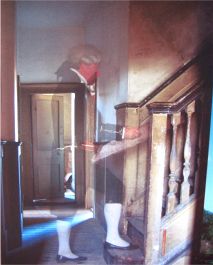
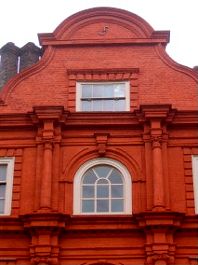 On the floor above there are a number of rooms that have not been touched since
the Palace became un-used and shut up. They remain with their original paintwork
and bare wood panelled walls. these rooms were the bedrooms of some of the
Princesses when they stayed at Kew and perhaps reflect their rather lonely life
in the palace. These rooms show the details of the building of the Palace from
its 1630's roots and how it was changed over the centuries. Up above these rooms
would have been the servants rooms within the attic.
On the floor above there are a number of rooms that have not been touched since
the Palace became un-used and shut up. They remain with their original paintwork
and bare wood panelled walls. these rooms were the bedrooms of some of the
Princesses when they stayed at Kew and perhaps reflect their rather lonely life
in the palace. These rooms show the details of the building of the Palace from
its 1630's roots and how it was changed over the centuries. Up above these rooms
would have been the servants rooms within the attic.
The whole experience of visiting this one time Royal Palace was very moving. It is a Palace that had seen such family joy for King George and Queen Charlotte, a joy which later was to turn to hell for them, as the King became ill and madness set in.
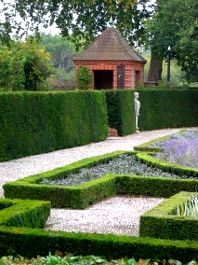 Leaving the Palace I had a walk round its formal gardens. These were not
original. At the back of the Palace, originally it was just a tree lined lawn
leading down to the river, but today there is a recreation of a formal garden of
the eighteenth century. To one side is 'The Queen's Garden'. During the 17th
century, plants were grown for culinary or medicinal purposes rather than for
their beauty. They would be used in cooking to mask the flavour of tainted meat.
They would also be strewn in houses to improve the air and make the atmosphere
sweet in an age when hygiene and cleanliness were not considered important.
Flowers were made into nosegays and carried in city streets to disguise
unpleasant aromas and help to ward off the plague. Although some of the herbal
remedies may seem odd to us today, some are gaining popularity once more in our
modern lives.
Leaving the Palace I had a walk round its formal gardens. These were not
original. At the back of the Palace, originally it was just a tree lined lawn
leading down to the river, but today there is a recreation of a formal garden of
the eighteenth century. To one side is 'The Queen's Garden'. During the 17th
century, plants were grown for culinary or medicinal purposes rather than for
their beauty. They would be used in cooking to mask the flavour of tainted meat.
They would also be strewn in houses to improve the air and make the atmosphere
sweet in an age when hygiene and cleanliness were not considered important.
Flowers were made into nosegays and carried in city streets to disguise
unpleasant aromas and help to ward off the plague. Although some of the herbal
remedies may seem odd to us today, some are gaining popularity once more in our
modern lives.
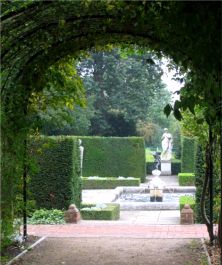
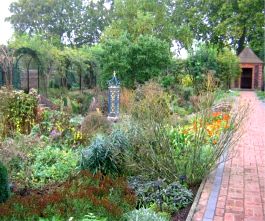
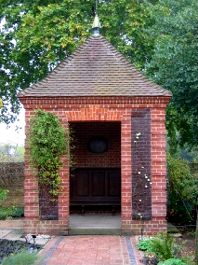
Kew Palace, was an amazing place for me to visit, with my passion for this period of the eighteenth century. I hope that my visit has also provided you with an insight of this interesting Palace restoration project and that you too may one day enjoy it for yourself.
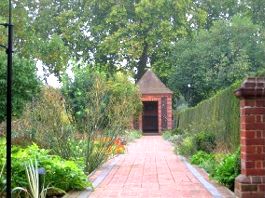
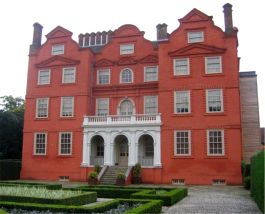
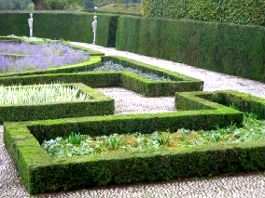
To review past newsletters, just follow this link:
Past newsletters.
To subscribe to this free newsletter -
Click here